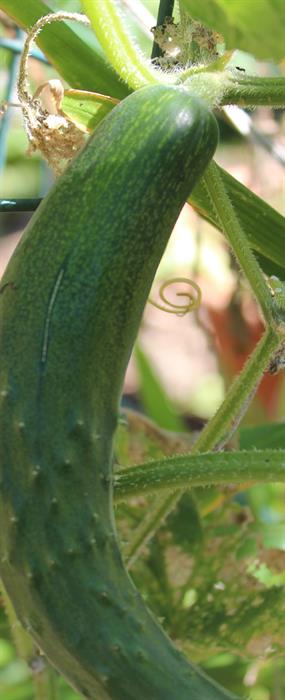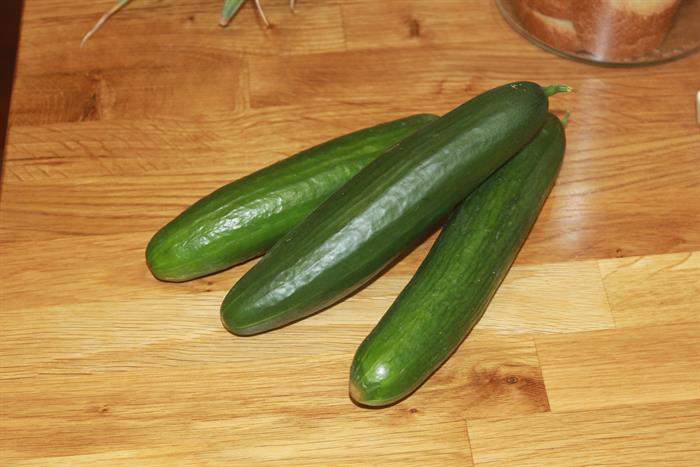Learn to grow Cucumbers
 In temperate climates, cucumbers are best started in Spring. In warmer places, it is possible to start them at other times as long as you can keep them warm enough. In warmer climes seed can be sown out directly into vegie beds or planters. Once soil temperatures begin to warm above 16°C they can be planted out elsewhere.
In temperate climates, cucumbers are best started in Spring. In warmer places, it is possible to start them at other times as long as you can keep them warm enough. In warmer climes seed can be sown out directly into vegie beds or planters. Once soil temperatures begin to warm above 16°C they can be planted out elsewhere.
For those started in pots, cucumbers are best grown by sowing the seed singly in individual pots. Peat pots are good because you won't have to disturb the roots when you transplant the seedlings. Use rich seed compost and plant them to three times the seed length. They'll need a fairly stable temperature of 18°C or over to germinate. You can expect the seedlings to emerge after about 4 or 5 days. In areas where average temperatures exceed about 27°C, seed will germinate within 2 days. As well as warmth, seed also needs good light intensity and a reasonable day length to develop.
Which Ones to Grow?
The best quality fruits are produced on plants which are fast to germinate from seed, and which grow into a full size plant quickly. If you have enough seeds, select only those seedlings which emerge within 5 days and discard the rest.
If you're buying them as seedlings, choose young seedlings that are growing strongly and avoid older seedlings that have obviously been in the container for a while. Plant out seedlings as soon as you can.
The best fruits are produced on female flowers. If you choose heirloom varieties you'll need to remove male flowers. Most modern cultivars produce only female flowers so there’s no need to worry.
A single plant grown well might be enough for the needs of some families. To be safe, a few different plants can provide a bountiful supply for several months from late spring through to autumn. In subtropical climates, cucumbers can produce for most of the year.
Growing Tips
- Cucumbers like warmth - choose a site which gets plenty of sun.
- Soil should be moist and fertile - enrich if necessary with slow release fertiliser and organic matter.
- Liquid feed may be applied fortnightly once fruits emerge.
- Keep the roots well-drained - don't saturate or they'll rot.
- Make sure they have sufficient ventilation - grow up a trellis or posts.
- Keep the roots warm in autumn to extend the growing season, even if air temperatures are beginning to drop. Apply mulch or grow in a greenhouse on a hot bed.
How to Grow
Cucumbers are trailing plants. As they grow they produce tendrils to help them climb up other plants or trees. In the vegie patch you will need to grow cucumbers on a climbing frame, trellis or tripod of stakes. To begin with tie the plants to the framework until they produce enough tendrils to support themselves.
They grow equally well in the ground, in a pot, or in hydroponics. Wherever you grow them, don’t crowd them together or with other plants. There needs to be plenty of room for air to move around them.
Harvest cucumbers as soon as the diameter is relatively uniform and “prickles" on the skin are starting to disappear. Don’t pull them from the vine because you may damage it. Use scissors instead. Once harvested keep them cool in the fridge - but not too cold or else they will develop sunken spots and quickly deteriorate. In cooler regions they'll last for a number of days in a cold store.
Eat them whilst crisp and fresh. The great thing is, you don't have to cook them to enjoy them!
Some Ways to Enjoy Cucumbers
- Sliced or diced and added to a salad.
- Diced and mixed with diced tomatoes, tossed in balsamic vinegar.
- On tuna sandwiches with a dash of white vinegar and sprinkle of black pepper.
- Neat cucumber sandwiches with fresh bread, butter and a little salt & pepper.
- Cucumber sticks with hummus or spring onion dip.
- Sliced julienne with spring onions and added to crispy duck & hoisin sauce pancakes.
- As an ingredient in homemade tzatziki.
Hint: Some people complain that cucumber repeats on them. Avoid this by removing the green outer skin, or grow ‘burpless’ varieties.
Fact: Gherkins are simply small-growing cucumber varieties which have been pickled.
Pests & Diseases
One of the biggest threats is “mildew”. This is a fungal disease that starts as powder-like white patches on a leaf. If not controlled, it can spread within days to cover an entire plant. Plants attacked by mildew become weak and susceptible to other problems, and will decline rapidly.
Mildew is more likely in hot and moist conditions, so the best way to avoid it is to keep individual cucumber plants apart. Try growing one or two in a vegie bed, and a couple of others in large pots in different parts of the garden. Pots close to a brick wall away from other plants tend to stay warm and well-ventilated.
How to Make Cucumbers Last
- Research has shown that the shelf life of a cucumber is longer when the fruit has developed faster - make sure you provide optimal growing conditions.
- Remove cucumbers from sources of warmth as possible after harvest.
- Fruit stores longer if kept out of direct sunlight - a cool, dark room or the refrigerator work best. They last longest at about 12°C.
- Fruit is sensitive to cold refrigeration - too cold and they turn mushy so don't keep in the chiller compartment or bottom shelf. Wrap in a tea towel and store in the crisper drawer.
- Cucumbers are more sensitive to ethylene than many other fruits (a chemical released by fruit which promotes ripening and decay). Don't store them next to tomatoes, melons or bananas.

You may also be interested in....